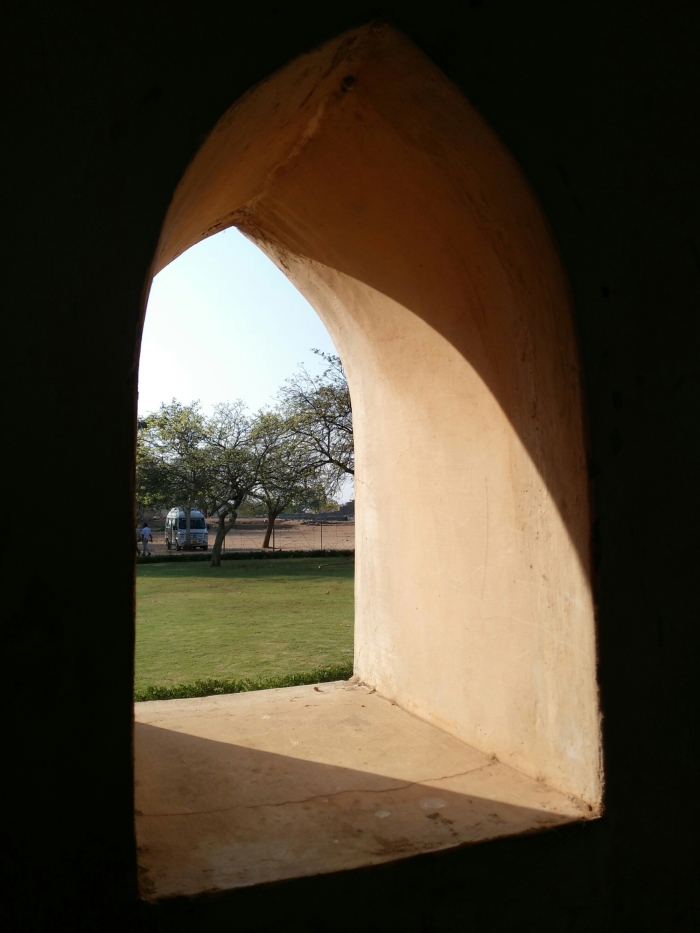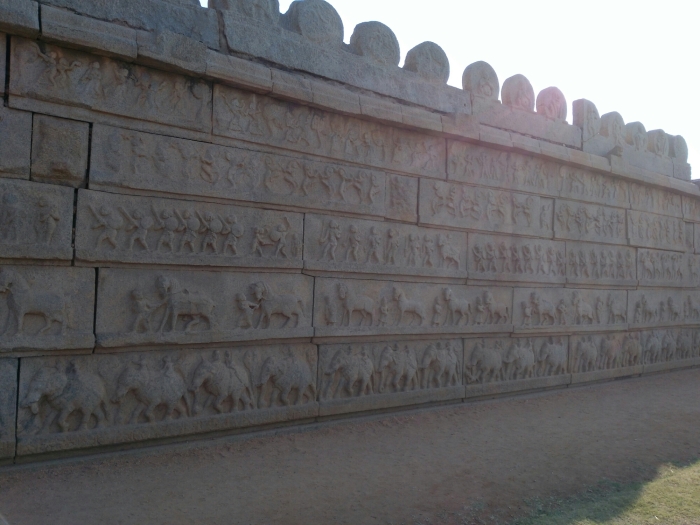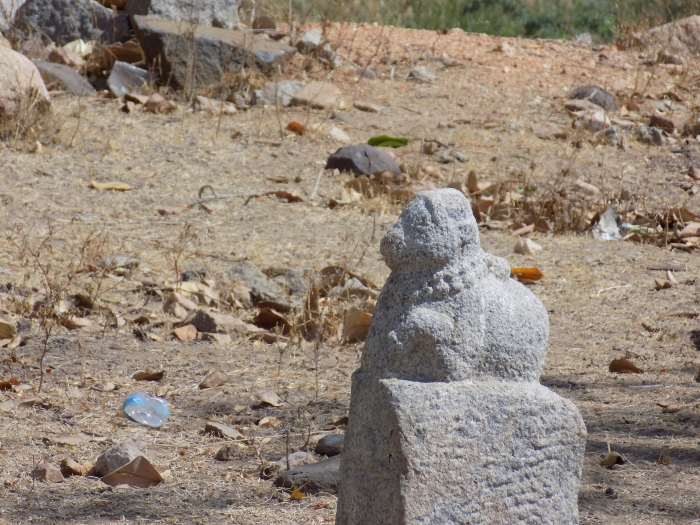A short story ‘Vijaystambha'(Pillar of Glory) written by renowned Indian author named Mr.V.S.Khandekar comes alive while you take a walk through Hampi. Yes, Hampi. A 700 years old ancient dynasty(well,now a heritage site by UNESCO) in India has many things to do for a history lover. So no surprise that it attracted me. Its been on my mind for long four year to experience the thrill of visiting a city from a golden era of Indian history. It has never been through any of my school books but yeah after my college, I came across the name HAMPI from somewhere and then search begun. Search took my four years to actually visit the place and witness the glorious era of southern India.
Now one would say, how can we witness what has happened 700 years ago. Even before the idea of cameras were actually would have been incepted. But trust me if you have a camera today, Hampi is a place your lense would crave for. The shine of the golden sparrow( India was known as) would lit up your imagination while you are gazing any of the stoney building of this city.

There is a visual delight of 1000+ buildings with a variery of carvings and designs. In a tour you generally cover just few major ones. Because others are either fallen,or burnt by the invaders or have lost their battle against time. Though you’ll see huge rocks everywhere and around this city,or you’ll feel that the place is just full of rocks everywhere, but let me warn you not to say that loudly while you are in Hampi,or else you’ll found yourselves rocked alive. (Yeah I am saying this while I am sitting 800kms away in Mumbai and writing this article). I am warning you with a reason, as there is a story for two huge rocks adjacent to each other which are known as ‘Two Sister stones’. Locals say, that the two sisters who were abusing Hampi village that its just a place full of rocks, got cursed and were forced to live rocky life ahead. In fact one of the stone is broken due to thunder storm, which they call as death of one of the sister…So beware, curses do work in here…

They say, in Hampi Gold & Silver used to be traded against elephants. This says it all about the wealth in ‘Vijayanagar'(the empire of which Hampi was part of). Vijaynagar was formed after invading raids of negatively famous Allah-ul-din Khilji. The founders of Vijaynagar were Chalukyas. ‘King Krishnadeva raya'(yes the one who had an intelligent chap Tenali Raman) is the ruler who has been popular for his strategies and constructing of temples have lived here in Hampi. His presence has added the importance to the place. Harihar & Bukka Raya founded this Vijayanagar empire.
To travel through Hampi, you have alternatives such as Rickshaws, motorcycles (Bullets too😊),even Karnataka state transport arranges a tour through this site. But if you ask me, if you are willing to get the best out of your to here, hire a mountain bike. Just for INR 150.(price as per Feb 2017.) For whole day. In the vicinity of Hampi Bazaar you’ll find many hiring points for various vehicles. These bikes are light-weighted which you can take to any place and riding becomes easy too.
The best thing to watch in Hampi is huge temples that are surrounded magnificent carvings on the wall. The extreme level of carvings you’ll find is in the building called ‘Hazaar Rama Temple.(1000 Ramas)’ The attraction in there are the 1000 carvings made on the walls of the temple. These carvings are basically every single incident from the scripture ‘Ramayana’.


While looking at these carvings and the perfection of the details on each of the carved sculptures,a question that definitely arises to your mind is, when did they get time to carve with so much perfection and on such a grand scale. And where are these hands now?? is concrete is the only solution for strength of the building??? does craftsmanship still exist in this soil??? (well too many questions actually) They say, whenever a new part was conquered & added to the empire of Vijayanagar, a new temple used to be built in that new area. The economics of ‘Vijayanagar’ used to have the second share specially allocated for erecting & maintaining the temples in the empire.
These temples used to be of various Indian deities & Gods. (anyways Hindu mythology has crores of Gods to choose from) So wherever you see, or your sight goes, temples are meant to be there.

As I am from the busiest city of India, the most fascinating thing I found was, the time. How did these people managed their time to build such a huge monuments, but then my mind said to me. “Dude, you’re looking at the building from a Golden era, when Indians never used to work for any corporations and international traders used to run behind Indians to get Gold and silver cubes, so chill.”
About temples one thing is really interesting is the story about ‘Varaha (a boar-faced God) temple’. Apart from Khiljis even Bahamanian sultans invaded this Vijayanagar and looted the whole kingdom multiple times. They even set the whole empire on fire that burnt the palaces, guest houses (yes they were built for staying of International traders who visited) made up of Sandalwood, even demolished the temples and defaced the idols in there. Today if you see the temples, they are just temples and the idols are either absent or exist with lost glory. But the Varaha temple was left unturned. The logic behind its survival was, a Boar is considered as forbidden, and if one breaks this belief is prohibited from worshipping Islam thenceforth. This belief somehow saved this temple from demolition for certain period but later it was broken with the help of canons without entering in this temple.

So this above image is of Acchyutaraya temple. Acchyuta raya was a king, who is considered as the weaker one. In fact locals say that, under his rule Vijaynagara started facing the downward trend. The glory started diminishing and raiders were benefitted under this weaker leadership. ‘Acchyuta’ is even a name of ‘Lord Vishnu'(an Indian God). So this temple is assumed to be of the God and not of the king.

The belief about the divine power was so strong that the kings constructed cisterns especially to store water for ruitine worships of Gods. Special arrangements were made so that water is collected and flown through rocky pipe like structures. Once that water is accumulated in a multi-level well, it was used dedicatedly for daily worships. These wells were called ‘Pushkarni'(literal meaning Lotus pond). Today you’ll find these Pushkarnis at various locations across Hampi.

By the way, I’ve just realised that I am sharing every detail in just a single post….why should I do this. Let me allow you to comment on this one and then force you to continue reading my upcoming posts which will have many other interesting reads like this one….stay tuned😉
Good job now I will surely visit this place with ur handy information
LikeLike
Wait for the next article….this one is just the first day….much more to explore….😉
LikeLike
Excellent post. When are you leaving for the visit to this place? A 800 km bike ride. Should take a couple of days at the most. What say?
LikeLike